Are you wary of common knee injuries in sports? This concise guide identifies the common knee injuries athletes face, signaling their symptoms and delivering straight-to-the-point prevention and management strategies. Stay informed and keep your knees safe as you push the limits in your sport.
Key Takeaways
- Knee injuries in sports are widespread and can range from ligament tears to chronic conditions like tendonitis and bursitis, with ACL and meniscus tears among the most common.
- Treatment for knee injuries can vary, including surgical and non-surgical options such as physical therapy and bracing; recovery often involves rigorous rehabilitation to restore stability and function.
- Prevention of knee injuries in athletes involves a combination of strength training, flexibility exercises, proper equipment, and conditioning, as well as strategies to manage overuse, such as cross-training and adequate rest.
Understanding Knee Anatomy and Its Role in Sports
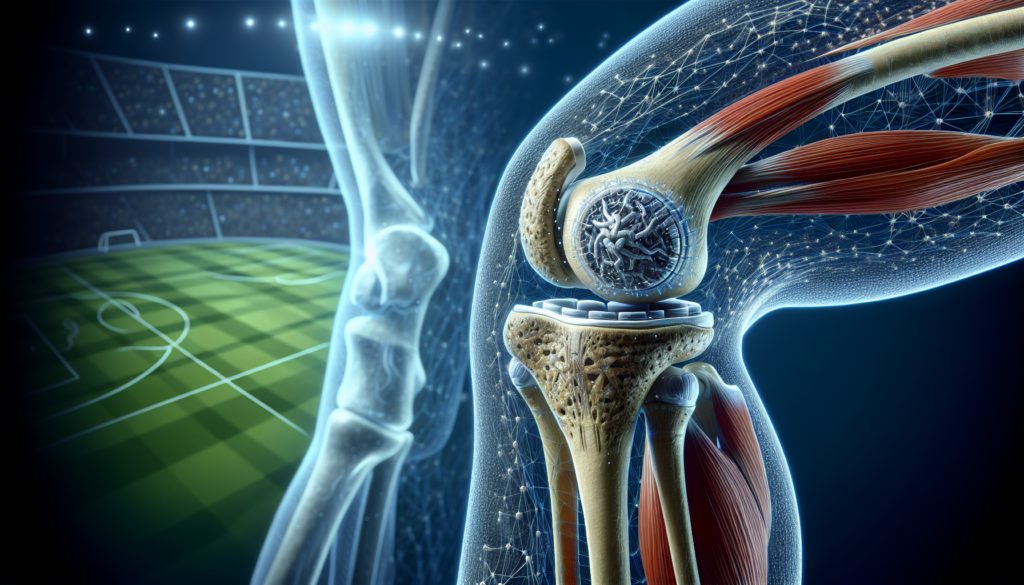
The knee, a marvel of nature’s engineering, is one of the most complex joints in the human body. Composed of three bones – the femur (thigh bone), tibia, and patella – it functions as a hinge joint, facilitating a range of movements from walking to high jumps. This complex interaction relies on a well-oiled machine of ligaments, cartilage, and muscles, all working in perfect harmony. But what happens when this harmony is disrupted by a knee injury?
Knee injuries are a common sight in sports medicine, with the most common knee injuries ranging from:
- ligament tears
- meniscal injuries
- chronic conditions like patellar tendonitis
- knee bursitis
These injuries can result in knee pain, swelling, and instability, affecting the athlete’s performance and quality of life. Understanding the anatomy of the knee, how it functions, and what can go wrong is the first step in preventing and managing these common knee injuries.
ACL Injuries: The Athlete’s Nemesis
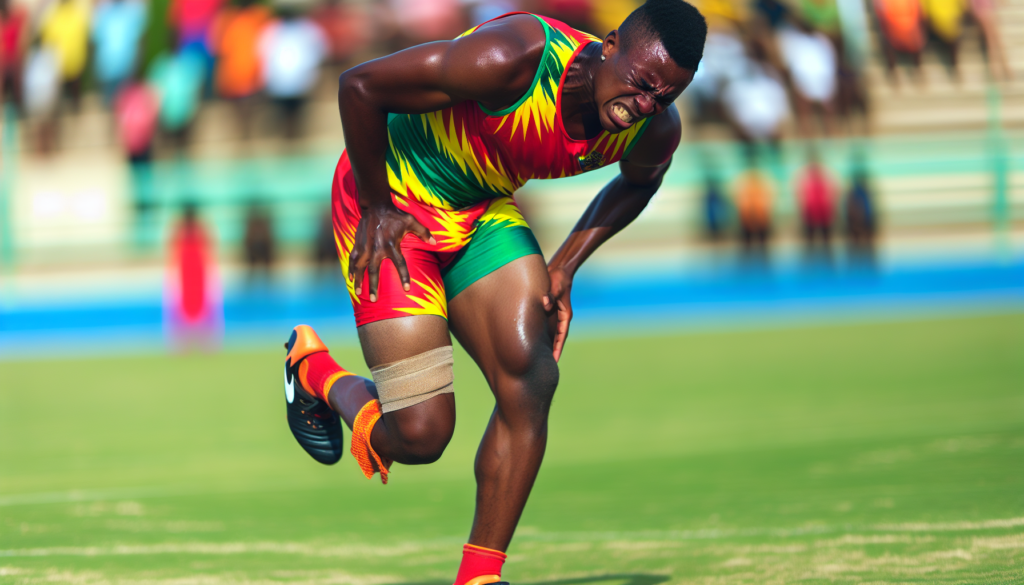
Imagine you’re a footballer in the heat of the game, you make a sudden pivot, and then – a sharp pain in your knee. You’ve just become another statistic in the world of ACL injuries. The anterior cruciate ligament (ACL), a crucial stabilizer of the knee joint, is prone to injuries during sports activities involving excessive leg extension or twisting. Severe pain and swelling are the telltale signs of this sports injury. While the focus is often on the ACL, it’s important to remember that the posterior cruciate ligament also plays a significant role in maintaining knee joint stability, and a posterior cruciate ligament injury can be just as debilitating.
But don’t despair, effective treatment options are available, as we’ll explore in the following sections.
Recognizing an ACL Injury
Swelling and tenderness in the knee after a fall or sudden twist could be indicative of an ACL injury. Diagnosing this injury involves a thorough physical examination, where the injured knee is compared to the uninjured one, and the knee’s range of motion and function are assessed. But the diagnosis doesn’t stop there.
X-rays, MRIs, and ultrasounds are used to confirm an ACL injury and visualize the extent of damage to the ligaments and other knee tissues.
Treatment Options for ACL Tears
Once an ACL tear is confirmed, the road to recovery begins. Initial treatment often involves physical therapy, knee bracing, and the use of crutches. For athletes aspiring to return to sports that require jumping, cutting, or pivoting, or when the knee keeps buckling during everyday activities, surgery may be recommended. ACL reconstruction surgery, which involves replacing the damaged ligament with a graft, may use techniques such as arthroscopy, the BEAR procedure, or lateral extra-articular tenodesis.
But recovery doesn’t end with surgery, as we’ll see next.
Recovery and Rehabilitation
Recovery from ACL reconstruction surgery is a rigorous process aimed at restoring knee stability and function. Rehabilitation involves at-home exercises starting within the first few days after the operation, followed by progressively challenging exercises under the guidance of a physical therapist.
An innovative treatment, known as blood flow restriction (BFR) therapy, can expedite muscle strength restoration and overall muscle building. The ultimate goals of rehabilitation are to reduce pain and swelling, restore the knee’s range of motion, and strengthen the surrounding muscles.
Meniscus Tears: Twists and Turns Leading to Injury
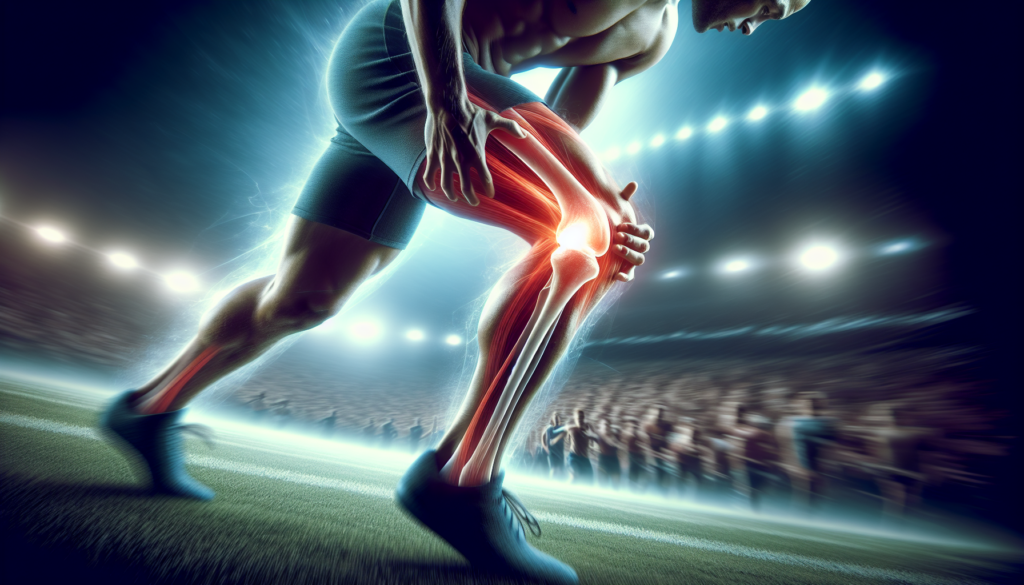
Ever twisted your knee during a game of football or while running? Such forceful twists or rotations can lead to meniscus tears, a common sports injury where the c-shaped cartilage cushioning the knee bones gets torn. Meniscal injuries are particularly prevalent in contact sports like football and running, where they are the second most frequent injury.
But how can you tell if you’ve torn your meniscus? Let’s dive into the symptoms and diagnostic processes next.
Identifying a Meniscal Tear
A meniscal tear can present itself through sudden pain, swelling, and a sensation of instability within the joint. To diagnose meniscal tears, doctors conduct a physical exam, assessing the knee’s range of motion and movement patterns, and comparing the injured knee to the uninjured one.
Diagnostic imaging, such as MRI, is essential in confirming a meniscal tear and visualizing the extent of the damage.
Non-Surgical vs. Surgical Treatments
Once a meniscal tear is confirmed, treatment options are weighed. Non-surgical treatments may include rehabilitative therapy, knee bracing, and the use of crutches. However, if the knee remains painful or stiff despite these conservative treatments, surgery may be considered.
Surgical options can involve sewing the tear back together or trimming the damaged tissue through arthroscopic methods.
Collateral Ligament Damage: Side Impact Woes
Not all sports injuries are due to twists and turns. Collateral ligament injuries occur when forces push the knee sideways, often during contact sports. The use of prophylactic knee bracing to reduce these injuries has shown mixed results, raising concerns about the potential increase in knee injuries associated with their use.
So, how can you tell if you’ve damaged your collateral ligaments? And more importantly, how can you heal them?
MCL and LCL Injury Symptoms
Injuries to the medial collateral ligament (MCL) and lateral collateral ligament (LCL) can manifest as pain on the inside or outside of the knee, accompanied by swelling and a feeling of instability. The severity of these symptoms can vary, ranging from mild damage in Grade 1 sprains, to a complete tear in Grade 3 sprains, which severely compromises the stability of the knee joint.
Healing the Collateral Ligaments
When it comes to healing collateral ligaments, treatment begins with bracing to protect the knee from further sideways force and stabilize the injured ligament. Depending on the severity of the sprain, a knee brace might be suggested for use during sports activities to prevent re-injury. Physical therapy focusing on restoring function and strengthening surrounding muscles is also an integral part of the healing process.
In severe cases, or for professional athletes, surgery may be necessary.
Patellar Challenges: Bursitis and Tendonitis
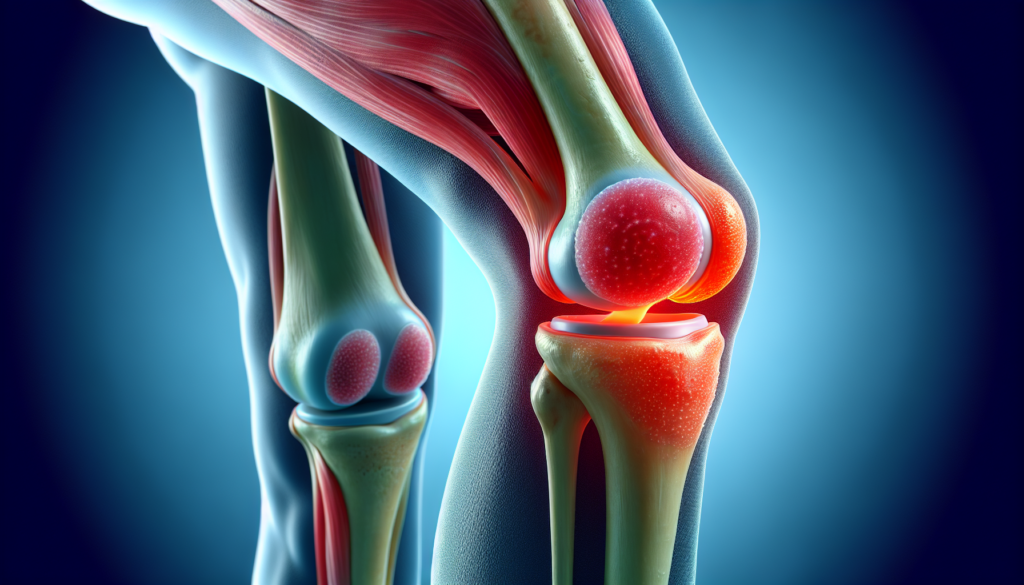
From ligament tears and meniscal injuries, we journey to the challenges of the patella: bursitis and tendonitis. Patellar bursitis occurs when the fluid-filled bursae in the knee become inflamed, leading to pain and swelling at the front of the knee.
On the other hand, patellar tendonitis is more common in athletes, particularly in sports with frequent jumping or rapid movements. Let’s delve deeper into these patellar challenges.
Understanding Patellar Bursitis
Patellar bursitis presents symptoms such as:
- Rapid swelling on the front of the kneecap
- Tenderness
- Warmth
- Increased pain during activity
Risk factors include underlying conditions like rheumatoid arthritis or gout, and activities that place continuous pressure on the knees. In serious cases, bacteria can enter a break in the skin leading to infectious bursitis which requires prompt medical intervention.
Treatment for patellar bursitis includes rest, icing, medication to reduce inflammation, and using protective knee pads. If non-surgical methods are ineffective, surgical options like bursa aspiration, corticosteroid injections, or even surgical removal may be necessary.
Combatting Patellar Tendonitis
Athletes with patellar tendonitis typically experience pain at the top of the shinbone under the kneecap, stiffness, and escalating discomfort with activities like squatting or descending stairs that generally worsens over time. The initial treatment for patellar tendonitis should involve rest, avoiding exacerbating activities, and conservative management including ice, anti-inflammatory medications, and short-term use of over-the-counter pain relievers.
Physical therapy focusing on rehabilitation exercises and hip stability can also help manage the condition.
Runner’s Knee: A Common Complaint in Sports Medicine
Another common complaint in the realm of sports medicine is runner’s knee, also known as Patellofemoral Pain Syndrome. This condition is characterized by pain around the kneecap, particularly when sitting with bent knees, squatting, jumping, or using stairs. Factors like overuse and joint alignment issues also contribute to the development of runner’s knee.
But how is runner’s knee diagnosed? And what can be done to treat and prevent it?
Diagnosing Patellofemoral Pain Syndrome
Diagnosing Patellofemoral Pain Syndrome begins with a detailed review of the patient’s medical history, focusing on the description of the knee pain, its location, and how different activities affect it. Next, a physical examination is conducted to observe the leg’s alignment and movement patterns.
The healthcare provider will inquire about specifics such as when the knee pain occurs, its exact location on the knee, and any activities that either alleviate or exacerbate the symptoms.
Treating and Preventing Runner’s Knee
Treatment for runner’s knee includes:
- Rest
- Ice
- Pain relievers
- Physical therapy focusing on rehabilitation exercises
- Hip stability exercises
These measures can help manage the immediate discomfort and long-term condition.
Support devices such as knee braces or patellar taping can alleviate pain and reduce peak patellofemoral pressure during recovery. Engaging in less strenuous sports during recovery, such as bicycling or swimming, is also recommended.
The Impact of Overuse: Chronic Knee Conditions in Athletes
Beyond acute injuries, the knee can also succumb to chronic conditions due to overuse. In sports, continuous strain on the knee can lead to conditions like Patellofemoral pain syndrome, iliotibial band syndrome, and quadriceps or patellar tendinopathy. These conditions can progress from pain during activity to severe outcomes like persistent pain and complete tendon disruption if not adequately managed.
But can these overuse injuries be prevented?
Strategies for Managing Overuse Injuries
Indeed, prevention is better than cure when it comes to managing overuse injuries. Here are some strategies to consider for managing and preventing overuse injuries in the knees:
- Cross-training: Vary your workouts to minimize repetitive strain on one set of muscles or joints.
- Proper stretching and strengthening techniques: Implement these to maintain flexibility and strength in the knees.
- Adequate rest periods: Allow for tissue recovery by incorporating rest days into your training schedule.
By following these strategies, you can help minimize the risk of overuse injuries in your knees.
In addition, the impact of environmental factors, including the surfaces they train on and the shoes they wear, can also influence the risk of knee overuse injuries.
Navigating Knee Dislocations and Fractures
While most sports-related knee injuries are due to overuse or twisting motions, knee dislocations and fractures are often the result of major trauma or significant twisting motions. These injuries require immediate care, often involving the RICE protocol:
- Rest
- Ice
- Compression
- Elevation
However, treatment for knee dislocations is influenced by the severity of the injury, age, general health, and activity level of the individual.
Immediate Response to Acute Knee Injuries
Acute knee injuries require an immediate response. Here are some steps to take:
- Ice the affected area to help reduce swelling.
- Immobilize the leg with temporary splints to prevent further damage.
- It’s crucial to avoid repositioning or manipulating the dislocated knee to prevent further injury.
Seeking prompt medical attention is essential, where professionals can realign the knee and evaluate the extent of damage. X-rays can also be used to assess for potential bone fractures following a knee injury.
Preserving the Athlete’s Knee: Prevention and Conditioning
Preserving the athlete’s knee is about more than just injury treatment – it’s about prevention and conditioning. Maintaining a healthy weight and wearing the right shoes are foundational conditioning practices to help manage the risk of developing overuse knee injuries in athletes.
Implementing dynamic warm-ups and proper stretching techniques before engaging in sports activities are essential preventive measures to minimize joint and ligament strain related to knee injuries. The use of protective equipment such as kneepads can also contribute to comprehensive knee injury prevention strategies.
Importance of Strength Training and Flexibility
The importance of strength training and flexibility in preventing knee injuries cannot be overstated. Here are some key points to remember:
- Weight training strengthens the muscles around the knee, providing better support and reducing the risk of injury.
- Incorporating strength training exercises two to three times weekly on nonconsecutive days is advised to keep workouts effective.
- Strengthening core muscles provides overall stability and support to the body, which is beneficial for knee health.
Proper stretching before activities, especially focusing on hamstrings, calf muscles, and quadriceps, is important to prevent knee pressure. Employing correct techniques during exercises and stretches is crucial to avoid stress on the knees and prevent overuse injuries.
The Role of Protective Equipment
Protective equipment plays a crucial role in preventing knee injuries. Knee braces are designed to keep the knee joint in alignment, offering stability and reducing the chances of injury. Prophylactic braces are utilized in contact sports to prevent potential knee injuries.
Protective gear such as knee guards is beneficial during activities that have a high risk of falls or repeated stress, such as rollerblading, biking, and certain sports, to reduce the risk of both acute and chronic knee injuries. However, it’s crucial for knee braces to fit snugly without inhibiting circulation or causing pain, which can be achieved by careful fitting and consultation with a healthcare provider or physical therapist.
In this journey, we’ve explored the intricate world of the knee – a marvel of nature’s engineering that bears the brunt of physical exertion in sports. From understanding the anatomy of the knee to delving into the specifics of common knee injuries such as ACL tears and meniscus injuries, we’ve highlighted the importance of prevention and management strategies. Remember, preserving the athlete’s knee is about more than just treating injuries – it’s about prevention, conditioning, and maintaining a healthy lifestyle. So, lace up those running shoes, strap on that knee brace, and let’s keep those knees healthy and strong.
Frequently Asked Questions
What is the most common knee injury in sports?
The most common knee injury in sports is an ACL injury, accounting for about 40 percent of all sports-related knee injuries. It can range from a small tear to a severe injury, such as a complete tear or separation from the bone.
How do I know what kind of knee injury I have?
You can know what kind of knee injury you have by consulting a doctor who may recommend an X-ray to rule out other causes of the pain and to determine if fluid has accumulated around the joint, indicating a sprain or strain.
What are the 3 C’s of the knee that can be torn in a sports injury?
The 3 C’s of the knee that can be torn in a sports injury are the anterior cruciate ligament (ACL), medial collateral ligament (MCL), and medial meniscus (MM). It’s important to be cautious about potential injuries to these areas when engaging in sports.
What are some preventive measures for knee injuries in sports?
To prevent knee injuries in sports, it’s important to maintain a healthy weight, wear proper shoes, do preventive exercises, use protective equipment, and avoid overtraining. These measures can significantly decrease the risk of knee injuries.
What are the symptoms of an ACL injury?
If you experience severe pain and swelling in the knee, it may indicate an ACL injury.




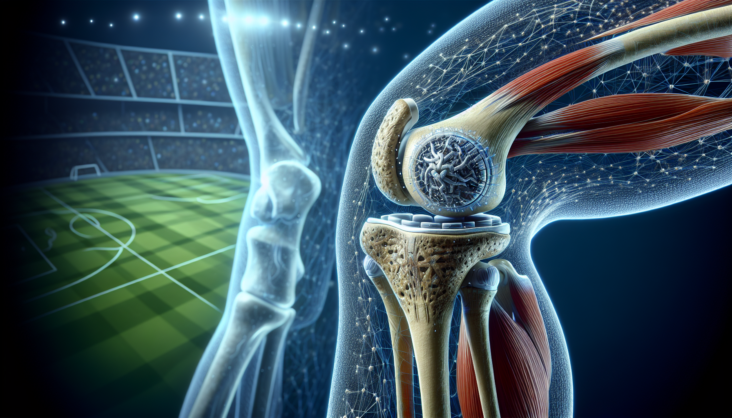
 William D. Murrell, MD
William D. Murrell, MD Thomas B. Evely, DO
Thomas B. Evely, DO Clifford Voigt, MD
Clifford Voigt, MD Karthikeyan Chinnakkannu, MD
Karthikeyan Chinnakkannu, MD Max N. Seiter, MD
Max N. Seiter, MD Demetris Delos, MD
Demetris Delos, MD Lauren M. Fabian, MD
Lauren M. Fabian, MD